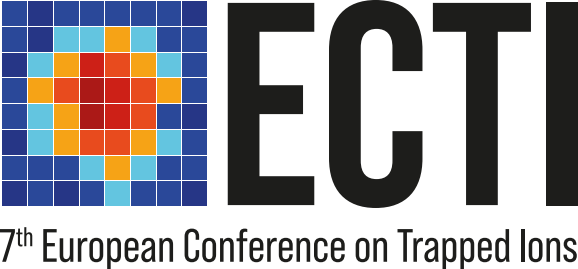Speaker
Description
The currently most accurate frequency standards based on optical transitions have reached fractional systematic uncertainties on the order of $1 \times 10^{-18}$, enabling sensitive tests of fundamental physics [1]. The Stark shift induced by room temperature blackbody radiation (BBR) in many cases causes the largest shift from the unperturbed transition frequency and limits the systematic uncertainty of the optical clock. For the $^{171}$Yb$^+$ clock the BBR shift evaluation is limited to the low $10^{-18}$ range by the knowledge of the differential polarizability $\Delta\alpha$ of the electric octupole (E3) transition at infrared wavelengths, if radiofrequency (rf) traps with small and homogeneous rf heating are used to confine the ion [2].
Measurements of $\Delta\alpha$ based on the Stark shifts from deliberately applied laser radiation are limited to a fractional uncertainty of about 1% due to the accuracy of optical power meters and imaging properties. For $^{40}$Ca$^+$ and $^{88}$Sr$^+$ [3] ions, however, the static differential polarizability $\Delta\alpha_\text{dc}$ has been determined with high accuracy from the specific trap drive frequency at which the micromotion induced second-order Doppler and Stark shift cancel each other. This is possible, because for both ions the clock transition features a negative $\Delta\alpha_\text{dc}$. Employing this high accuracy, we can use $^{88}$Sr$^+$ as an in-situ sensor to evaluate the temperature rise from rf losses of an ion trap with low thermal conductivity with 1 K uncertainty [4]. This allows us to determine the unperturbed frequency ratio of the $^{88}$Sr$^+$ and $^{171}$Yb$^+$ clock transitions to a fractional uncertainty of $2.3 \times 10^{-17}$ and to infer the $^{88}$Sr$^+$ absolute frequency [4].
To enable frequency uncertainties on the $10^{-19}$ level for $^{171}$Yb$^+$, we aim to transfer the uncertainty of Δα from $^{88}$Sr$^+$ to$^{171}$Yb$^+$ through measuring the light shift induced by a 10 µm CO2 laser beam for 88Sr+ and the two clock transitions of $^{171}$Yb$^+$. To minimize the polarizability uncertainty of $^{88}$Sr$^+$ at 10 µm, we investigate the dynamic behavior of $\Delta\alpha$ by measuring its zero-crossing around 1540 nm.
[1] S. M. Brewer et. al., Phys. Rev. Lett 123, 033201 (2019)
[2] T. Nordmann et. al., Rev Sci Instrum 91, 11301 (2020)
[3] P. Dubé et. al., Phys. Rev. Lett 112, 173002 (2014)
[4] M. Steinel et. al., arXiv.2212.08687 (2022)

